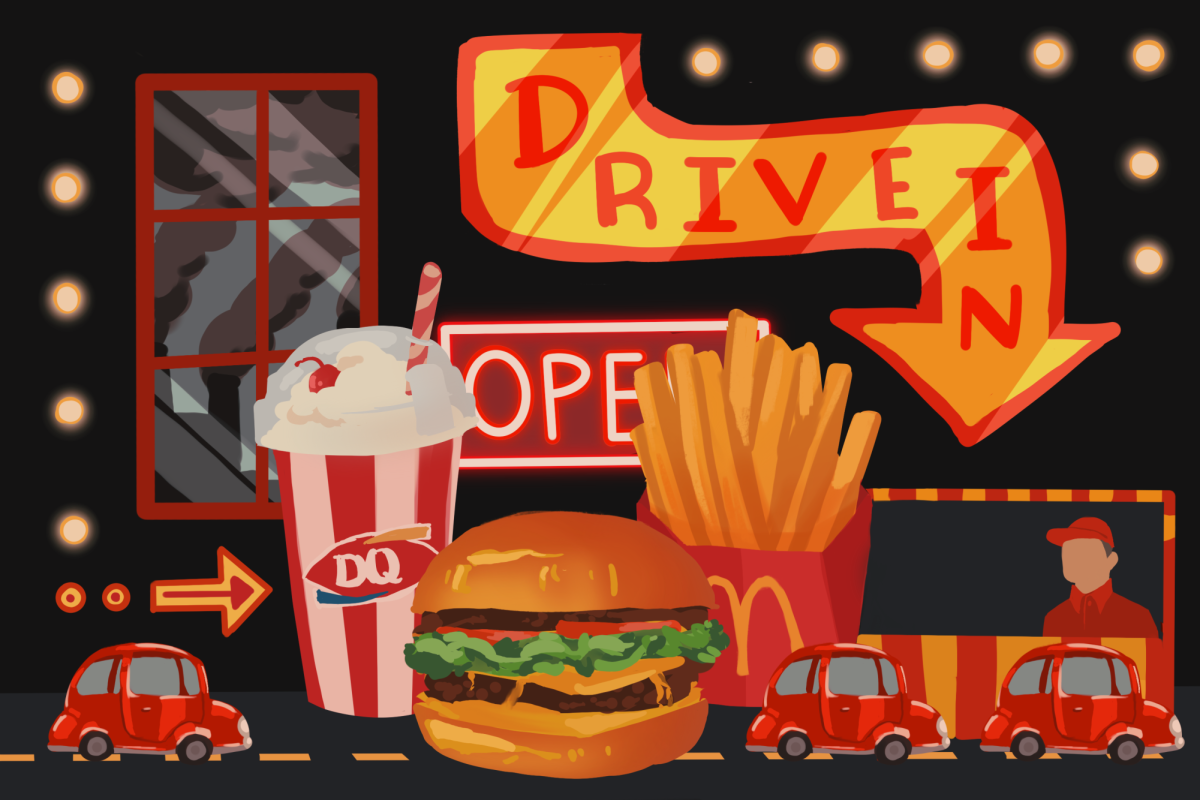Flickering neon signs, bright colors, and dazzling interiors. Constructed on the high of the Highway Craze, fast food was born on the crest of Americana ideals: cheap, reliable, and most importantly, fast. With car ownership booming in the Roaring Twenties, restaurants began gearing towards drivers and the open road: in 1921, White Castle was founded in Kansas, and with it, the introduction of assembly line-based food preparation. Following suit in the 1930s, drive-in movies hit the mainstream, and more focus turned towards making quick meals and cheap food part of the car-dominant American Dream. In the 1940s, French fries, burgers, and milkshakes established themselves on menus at drive-thru restaurants, and in 1958, President Dwight D. Eisenhower’s Highway Act pushed America towards suburbia, and with it, cheap and reliable fast food. With rapidly increasing suburban blocks, little room was left for restaurants and family businesses.
Instead, fast food franchises took over, and with more and more Americans traveling by car and highway, chains like McDonald’s and KFC became a sign of consistency: no matter where you were, you were sure to get the same speedy service and food.
Moving into the 21st century, fast food grew to be part of American pop culture as well, not only through catchy advertisements like KFC’s slogan “Finger Lickin’ Good” or the trademark McDonald’s jingle, but also through a broad presence in American media. In 2014, for example, fashion brand Moschino’s creative director Jeremy Scott based several 2014 Autumn/Winter designs around the iconic McDonald’s logo. Another major advertising force is product placement, wherein products are mentioned or shown in some form of media, such as Domino’s in Teenage Mutant Ninja Turtles or KFC in South Park.
Yet product placement isn’t just limited to television or fashion; according to a 2019 study by the American Academy of Pediatrics, fast food was mentioned in over 20% of Billboard’s Top 100 Songs, such as Justin Timberlake’s Carry Out mentioning IHOP or Fergie’s Glamorous with Taco Bell. Furthermore, with the advent of online mass media and widespread celebrity culture in recent years, more brands, including fast food chains, have been increasingly partnering with pop stars, actors, and models to drive sales through collaborative celebrity meals. Artists like Snoop Dogg, BTS, and Megan Thee Stallion have partnered with Jack in the Box (2023), McDonald’s (2021), and Popeyes (2019), respectively.
But fast food’s image hasn’t remained as glamorous as it once was. With more and more research emerging on the adverse health effects of fast food chains’ line-ups, pressure has begun to mount on corporations to change their methods. Outdated food laws and complex bureaucratic processes have further muddled the health impacts of American foods. After all, due to a rule change in 1997, companies are allowed to self-regulate the additives located in their products, so long as they deem it to be “generally recognized as safe,” or GRAS, without the need for the US Food and Drug Administration’s approval or knowledge. This has further worsened the problem, as, according to the National Public Radio, “In the past five decades, the number of food additives has skyrocketed—from about 800 to more than 10,000. They are added to everything from baked goods and breakfast cereals to energy bars and carbonated drinks.”
In addition, fast foods can be classified as ultra-processed foods, which UCLA Health defines as “foods that have been so radically changed from their original state that they neither look nor taste like the ingredients from which they are made.” In the pursuit of fast and efficient meals, ultra-processed foods have become high in sodium, saturated fats, and added sugars, which contribute to a range of health problems. These include an increased risk of Type 2 diabetes, cardiovascular disease, lowered immune response, certain cancers, dementia, and early death.
Yet, most other nations are not as plagued with the health problems posed by the products of name-brand chains as the United States is. For example, in France (McDonald’s second largest market after the US), the food is locally sourced and of high quality. French and European Union food laws are much stricter in comparison to the US; per the European Union’s Regulation (EC) No 1333/2008 on Food Additives, “Food additives must be safe when used, there must be a technological need for their use, and their use must not mislead the consumer and must be of benefit to the consumer.”
In addition, under EU law, “traceability” is enforced, meaning that through all stages of production, processing, and distribution, anyone has the ability to track any food, food-producing animal, or substance used for consumption. Such measures do not exist in the US as of today but allow for higher transparency and accountability within the fast food industry and the food industry overall, ensuring that quality is retained as much as possible.
Regardless of location, fast food greatly impacts our steadily changing climate. Cows are the primary agricultural source of greenhouse gases worldwide; each year, a single cow will emit about 220 pounds of methane. Yet, fast food and takeout-style meals have been another major contributor to food waste in the US. Per the US Environmental Protection Agency, resources that go into a year of food loss and waste equate to “an area of agricultural land equal to California and New York; greenhouse gas emissions of more than 42 coal-fired power plants; enough water and energy to supply more than 50 million homes; and the amount of fertilizer used in the U.S. to grow all plant-based foods for U.S. human consumption.”
Fast food’s quick, fast, and efficient allure has held American culture in a tight chokehold for well over a century. In fact, November 16 is considered the official National Fast Food Day, and celebrities are regularly seen participating in commercials and social media advertising for fast food.
Fast food has become an integral part of Americana, and it reflects the shifts and flows of the American Dream: consistent “quality” food, reliably served in every suburb of the nation, with freedom of choice cleverly disguising the striving for conformity. And hidden below it all are the consequences of a nation that grew faster than it could adapt, resulting in harm not only to ourselves but also to the world around us.





































































